If you’ve ever watched The Suze Orman Show, you might find this video as funny as any Fey/Palin skit. The impression is right on; I totally missed it when it first aired.
Via a post by ddb on the Bogleheads forum.
If you’ve ever watched The Suze Orman Show, you might find this video as funny as any Fey/Palin skit. The impression is right on; I totally missed it when it first aired.
Via a post by ddb on the Bogleheads forum.
You can grab a quick 150 American Airlines AAdvantage miles by visiting this website and watching a quick video about $300 Bose headphones. Earn another 350 miles if you stop by a Bose store and do a live demo. Expires 10/31/08. Posts in 6-8 weeks. Should be useful for delaying expiration of miles.
Okay, so I couldn’t think of a good title… but think about it after reading these helpful articles. 😉 I’m including some excerpts I like, but I would highly recommend reading each piece in its entirety. Good stuff.
Warren Buffett: Buy American. I Am.
So … I’ve been buying American stocks. This is my personal account I’m talking about, in which I previously owned nothing but United States government bonds. (This description leaves aside my Berkshire Hathaway holdings, which are all committed to philanthropy.) If prices keep looking attractive, my non-Berkshire net worth will soon be 100 percent in United States equities.
Why?
A simple rule dictates my buying: Be fearful when others are greedy, and be greedy when others are fearful.
Of course, I don’t remember him ever writing an Op-Ed saying “Be 100% Bonds, I am”, or “Hedge Against The Dollar, I Am”. However, I do agree that if you are going to buy stocks, now is a fine time to buy. I am maintaining my asset allocation, and I’m not even doing it grudgingly – I’m doing it happily.
Hedge Fund Manager Andrew Lahde’s Goodbye Letter
I will no longer manage money for other people or institutions. I have enough of my own wealth to manage. Some people, who think they have arrived at a reasonable estimate of my net worth, might be surprised that I would call it quits with such a small war chest. That is fine; I am content with my rewards. Moreover, I will let others try to amass nine, ten or eleven figure net worths. Meanwhile, their lives suck. Appointments back to back, booked solid for the next three months, they look forward to their two week vacation in January during which they will likely be glued to their Blackberries or other such devices. What is the point? They will all be forgotten in fifty years anyway. Steve Balmer, Steven Cohen, and Larry Ellison will all be forgotten. I do not understand the legacy thing. Nearly everyone will be forgotten. Give up on leaving your mark. Throw the Blackberry away and enjoy life.
This guy bet big on the collapse on the subprime mortgage market and got great returns the last few years for his small hedge fund. He brings an interesting point of what drives people to super-duper-richness. I would probably do the same as Lahde, but others would keep reaching for more. Buffett’s new biography The Snowball also goes in the family life sacrifices/choices he made. The end part about hemp… is there a hidden correlation?
Bogle & Bodie On Wise Diversification
Jack Bogle: I am a believer in diversification. You buy index funds for stocks, and your bond portion should equal your age. This is how I invest, so I know how little it’s hurt me to have a substantial position in U.S. bonds. I’m in half Treasuries, half corporates.
[…]In recent years, international investing has had a higher correlation with the U.S. market than was traditional. If you invest internationally, you have to invest in foreign companies not as diversifiers but wealth producers. If you like international, get in gradually, maybe with 20% of your portfolio, half in developing markets and half in emerging markets. Europe looks a lot like us, so it’s at least possible you might get a better return out of emerging markets. I don’t invest internationally myself.
Zvi Bodie: […] And then there is insuring or hedging. That’s when you’ve got a safe asset and to my mind that is Treasury Inflation-Protected Securities, or TIPS. One way to protect yourself is to combine a diversified portfolio of risky assets with the safe asset. We teach students that you only need two mutual funds—the risky assets and the safe asset—to generate the entire set of risk-and-reward trade-offs.
This past week, I made some minor tweaks to my investments. No, I didn’t go all cash! Previously, I had set the bond portion of my portfolio to be 50% short-term Treasury bonds and 50% Treasury inflation-protected bonds (TIPS). I use the mutual funds VFISX and VIPSX. However, this week I shifted my allocation to be 25% short-term Treasury bonds and 75% Treasury inflation-protected bonds (TIPS).
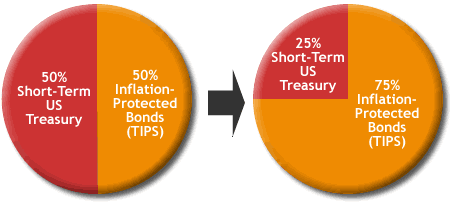
Comparing Yields to Find Expected Inflation
You can compare the nominal yield of the Treasury bonds and the real yield of TIPS and find the implicit expected inflation. For example, if a 20-year Treasury bond yields 5%, and TIPS yield 2% real, then the expected inflation is the difference, or 3%. (If inflation is 3%, then the nominal yield of TIPS becomes 2% + 3% = 5%.)
This week, the expected inflation over the next 10 years has been hovering around 1%, some of the lowest in a long time. On Monday, the 10-year Treasury yield was 4.08% and the TIPS real yield was 3.05% (source: US Treasury), for an expected inflation of 1.03%. As of Friday, the gap was 1.02%. For the 20-year bonds, the gap predicted inflation of a about 1.6-1.8%. If the actual inflation rate turns out to be greater than these values, then holding TIPS will result in a higher yield over time.
Here is a chart of annual CPI-U changes over time (source: BLS.gov). The red line is the 10-year moving average:
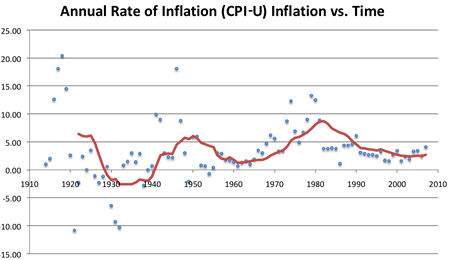
Yes, there are deflation worries in the near future, but you can see the only decade that inflation has averaged below 1% was during the Great Depression. Not only that, but our currency was still on the gold standard then.
Currently High Real Yields
As mentioned earlier, the current real yields offered by TIPS of around 3% are also the highest in many years:
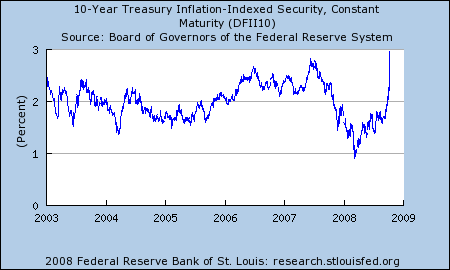
Since real yields are rising, the value of existing TIPS have actually dropped. So I’m buying low. 🙂 If real yields rise any higher, I’d buy even more.
Making The Change
There are many things to consider out out there, like global demand and the infamous $700 Billion bailout package (where do you think this money comes from?), but I only see more spending and borrowing down the road. With the printing presses available to go full blast, and lots of future promises made, I just can’t see inflation being this low for a decade.
Combine this with the fact that TIPS have a historically high real yield, it would seem like the market is overreacting. Although I usually don’t make such changes, I decided to go for it. So far, I have chosen not to go with 100% TIPS because I wanted to maintain some of the benefits of short-term treasuries, like lower volatility and low correlations with other assets. It’s kind of tough though, as the yields are horribly low right now due to the flight-to-quality.
I haven’t increased the target amount of total bonds in my portfolio, although due to the current drift and limitations due to juggling separate accounts, they are now 18% instead of 15%. I still believe in stocks as well due to their low valuations, and have also made equities purchases this week to re-balance that side of my portfolio. I am expecting to invest another $10,000+ before the year ends.
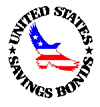 New inflation numbers are out, so it’s time for the usual semi-annual update:
New inflation numbers are out, so it’s time for the usual semi-annual update:
New Inflation Rate
March 2008 CPI-U was 213.528. September 2008 CPI-U was 218.783, for a semi-annual increase of 2.46%. Using this official formula, the variable interest rate for the next 6 months will be approximately 4.92%.
Buying Now? If you buy before the end of October, the fixed rate portion of I-Bonds will be 0%. You will be guaranteed an variable (well… total) interest rate of 4.84% for the next 6 months, and 4.92% for the six months after that. You can’t redeem until 12 months have gone by, and any redemptions within 5 years incur a 3-month interest penalty.
A known “trick” with I-Bonds is that if you buy at the end of the month, you’ll still get all the interest for the entire month as if you bought it in the beginning of the month. Let’s say we buy on October 31st. You’ll be able to sell on October 1st, 2009 for an actual holding period of 11 months. (3-month interest penalty still applies.)
Not bad as a place for short-term cash reserves, but not necessarily the best. There are certificates of deposit with comparable interest rates, and you can still access your money early in an emergency.
Buying Later? If you wait until November 1st, you will get a new unknown fixed rate + ~4.92% for the first 6 months, and an unknown rate based on ongoing inflation after that.
Bought already? For those that bought back in April when the fixed rate was 1.2%, the next reset rate will be 1.2% + 4.95% = 6.15%. So we got 4.38% from April-September, then 6.06% from October-May, and now 6.15% from April-September ’09. And this is not counting that the interest is exempt from state income taxes. Yep, I’m keeping these for another 6 months. 🙂
Beware Low Purchase Limits
The annual purchase limit is now $5,000 in paper I-bonds and $5,000 in online I-bonds per Social Security Number. For a couple, that’s $20,000 per year. Buy online at TreasuryDirect.gov. As for paper, here is a post on how to buy paper savings bonds from your local bank. I am already nearly maxed out for this year already, and don’t think I’ll be buying any more.
These days, a lot of people are asking themselves this very question. For most, including myself, I have a unsatisfying answer:
We don’t save enough money.
Think about it. If I had a billion dollars and my current lifestyle, I could simply build myself a Scrooge McDuck vault and just spend it gradually. No banks, no stocks, no bonds.
But I don’t. I have to try and fund both our ongoing and future expenses with our income. In order to make this more likely, I need higher returns. Unfortunately, this sometimes means investing in things that are riskier. Things that can drop 45% in less than a year!
What kind of after-inflation returns can I expect from stocks?
I explored the sources of long-term stock returns here. But as correctly pointed out they are nominal (before-inflation) returns . What about real (after-inflation) returns? Isn’t that what really matters?
Here is the adjusted equation:
Historically, the real earnings growth has been estimated at around 2%. At current depressed prices, the dividend yield of the US Stock Market as a whole is about 3%. Thus, this suggests that we can expect 5% real returns before expenses.
But don’t take my word for it, take it straight from Warren Buffett, in this semi-famous 1999 Fortune magazine article:
Let me summarize what I’ve been saying about the stock market: I think it’s very hard to come up with a persuasive case that equities will over the next 17 years perform anything like–anything like–they’ve performed in the past 17. If I had to pick the most probable return, from appreciation and dividends combined, that investors in aggregate–repeat, aggregate–would earn in a world of constant interest rates, 2% inflation, and those ever hurtful frictional costs, it would be 6%. If you strip out the inflation component from this nominal return (which you would need to do however inflation fluctuates), that’s 4% in real terms. And if 4% is wrong, I believe that the percentage is just as likely to be less as more.
4% real return, which was after taking out 1% in assumed management fees and commissions, again brings us back to 5% after-inflation returns from stocks. In exchange, we get a lot of volatility – big dips and peaks, and the dips can last a long time.
What if we wanted to take minimal risk?
I am nearly done with reading a book by economist Laurence Kotlikoff and financial advisor/columnist Scott Burns called Spend ‘Til the End: The Revolutionary Guide to Raising Your Living Standard–Today and When You Retire. In it, instead of recommending a portfolio of mostly stocks and adjusting from there, they start from the other direction. They believe you should start with a portfolio consisting entirely of inflation-protected bonds and see if you need more return from there.
Treasury Inflation-Protected Securities (TIPS) are bonds issued and backed by the U.S. government that promises you a total return that adjusts with inflation. Very generally, it works like this: if the stated real yield is 2% and inflation ends up at 4%, your interest payment would be 6%.
Coincidentally, the last few weeks have given us a huge surge in the real yield offered by TIPS, around 3%. This is the highest it has been in many years:

If you had enough money, such that a fixed 3% after-inflation return is adequate for your needs, then you wouldn’t have to take on very much risk. You wouldn’t have to own any stocks at all. Of course the market value of these bonds will still vary along the way, but if you hold until maturity you will get the real yield. And it is guaranteed by the government, just as much as “regular” Treasury bonds.
More thoughts…
If you invested $5,000 inflation-adjusted dollars every year for 30 years, with a 3% return you would end up with $257,000 in today’s dollars. If you invested the same amount at 5% you would have $370,000 – 44% more.
Of course, 100% stocks or 100% TIPS are at two extremes. But as you can see, either saving more (or living on less in retirement) allows us the luxury of needing to take less risk. Which means in times like these you’d be much less stressed. The question is, can we save enough money to pull this off? I don’t know, but I think I may try harder now. 🙂
 Here is an e-mail coupon for a free Tall Cappucino at a Barnes & Noble Starbucks. There is also a coupon for 15% off one item. Expires 10/31/08. Via FW.
Here is an e-mail coupon for a free Tall Cappucino at a Barnes & Noble Starbucks. There is also a coupon for 15% off one item. Expires 10/31/08. Via FW.
Sadly, for me the main draw of this offer is that with a Starbucks drink I can actually find a place to sit and browse through books inside Barnes. (They kick you out of the cafe area if you’re not a customer and it’s crowded.) The last time I actually found an open couch was probably 2005. The 15% off may be useful for those times when you simply can’t wait to go home and order it from BN.com or Amazon.com for 30% off…
 Well, the big boys are getting their rescue/bailout plan, but I guess ours got lost in the mail… So what should we do? I think that everyone should take a second look at their cash reserves. Do you have enough?
Well, the big boys are getting their rescue/bailout plan, but I guess ours got lost in the mail… So what should we do? I think that everyone should take a second look at their cash reserves. Do you have enough?
What Job Security?
These days, I don’t see any job as safe. My company went from interviewing people to hiring… nobody. Even local and state governments are facing major budget deficits. At a minimum, I would want a few months of living expenses to tide me over until I find another job. I still remember the dot-com bust days when former tech workers ended up living in their cars.
A Reason Not To Invest In Stocks
Hey, if you’re looking for an excuse not to buy any more stocks for a while, beefing up your emergency fund is not a bad one. Any money you may need within 5 years should be in cash or short-term investments anyway.
A Reason *To* Invest In Stocks
Ironically, after you build up a nice cushion, it may actually make you feel better about investing in the stock market. I definitely helps me to keep short-term money separate from long-term money. As such, I’m still applying my upcoming income towards maxing out my 401(k) for 2008. But after that, I will probably start to save another three months of living expenses, for a total of 9 months in cash.
Less Credit Available
A lot of people used to simply assume that their home equity line of credit (HELoC) could serve as their emergency fund. But these days, it just takes one letter in the mail that says your HELOC is frozen or greatly reduced. You don’t want to be forced into taking an early withdrawal from your 401(k) or IRA, or paying exorbitant credit card interest.
If anything, apply for a credit card with a low fixed interest rate now while it is still offered. Here is a list of no fee 0% APR balance transfer credit cards. Just buy goods as you regularly would, and pay the minimum while saving the difference in an interest-bearing account. (Don’t go buying more stuff, obviously!)
Looking Ahead
For me, an alternative reason for increasing my cash reserves is that I can also use it later for investing in real estate. I still don’t see many opportunities with good cashflow right now, and may not see them for another couple of years. But I want to be ready, as the no-money-down days may never come back.
Where do you keep it?
As long as it is safe and liquid, I just go by rate. Use the new FDIC insurance estimator if you have lots of money. Both Vanguard and Fidelity are participating the money market fund insurance program, so they are super-duper safe now. . Well, your old money is safe. Still, I consider money market funds with Fidelity and Vanguard as safe as FDIC-insured, although this is only my opinion. However, my cash is currently split between:
 Quicken Online is now free. It used to cost $3 per month ($36/year). This established brand name is now directly competing with other free online account aggregation services like Mint, Geezeo, Wesabe, and Yodlee MoneyCenter. I guess they decided it would be better to give this product away for free as well, in the hopes that they can sell you TurboTax or the desktop Quicken later on. 😉 I signed up; here is a screenshot:
Quicken Online is now free. It used to cost $3 per month ($36/year). This established brand name is now directly competing with other free online account aggregation services like Mint, Geezeo, Wesabe, and Yodlee MoneyCenter. I guess they decided it would be better to give this product away for free as well, in the hopes that they can sell you TurboTax or the desktop Quicken later on. 😉 I signed up; here is a screenshot:
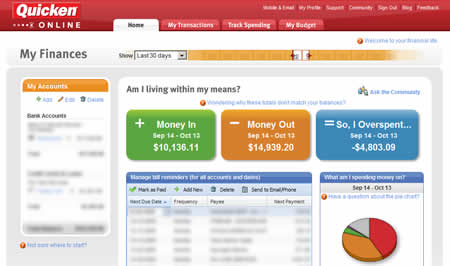
Although I keep meaning to do a more in-depth review of all these services, I have not done so yet because after trying each of these services briefly I always end up going back to my trusted Yodlee MoneyCenter. I have been disappointed in how they all (including Yodlee) unsuccessfully attempt to categorize my purchases, and I am unwilling to keep manually correcting them.
I prefer the simple “snapshot” feel of Yodlee, where I can see all my balances and investments at a glance, along with recent transactions. I can even keep track of my frequent flier miles and other rewards points. Each day I log in, acknowledge any changes, and am done within 5 minutes. “Get in, get out, get on with your life”.
Other more personal (and lame) reasons include sheer habit, as I have been using Yodlee since 2004. Finally, I have a lot of accounts, and the idea of having to re-enter all those passwords again is not appealing at all.
All of these sites take your logins and passwords, and essentially pretend to be you and scrape the pertinent information off each webpage using a script. Yodlee actually sells its account aggregation services to Mint. Geezeo uses CashEdge. Quicken Online and Wesabe have their own systems. Be aware that in many cases you are giving them limited power of attorney to do this. It’s all in the terms and conditions! Many people wisely are very skeptical of handing over all their passwords to a third party. I have previously posted a modest defense of my use of Yodlee here.
 In my last Amazon.com order, there was a flyer for 250 free business cards from Intuit Quickbooks. I have been meaning to get new business cards with my new address, so I tried it out. Even in this digital age, business cards are a great way to publicize your home business or freelance work. Pass them out!
In my last Amazon.com order, there was a flyer for 250 free business cards from Intuit Quickbooks. I have been meaning to get new business cards with my new address, so I tried it out. Even in this digital age, business cards are a great way to publicize your home business or freelance work. Pass them out!
The ordering process was easy, and UPS Ground shipping was $5. I kept things pretty simple, and did not add a custom logo for extra money or any other options, and it was $5 total with no sneakiness. Very cheap advertising, not to mention it is a deductible business expense. 🙂 The order shipped in 3 days.
From looking at the 42 available free designs, it would appear that these are the same offered by Vistaprint. I have used Vistaprint before with no problems, but others have reported issues with them. Vistaprint does try to cross-sell you a lot of different trial offers with various companies before letting you check out with your free business cards. Quickbooks did not. Also, Vistaprint puts their logo on the back of the free cards, which some feel makes the cards look less professional. Quickbooks does not.
Why do we think that the stock market will always go up? Why has it gone up over long periods of time historically? For instance, let’s look at this graph:
There is one theory that I have read about in the writings of respected authors like Jack Bogle and William Bernstein. It states that there are three main components to long-term stock market performance:
Part 1: Dividend Yield
Obviously, if your stock distributes 2% in dividends each year, then you will have a 2% contribution towards of return.
Part 2: Earnings Growth
If earnings stay constant, then all other things equal, one would expect the share price of your company to stay constant as well. If the earnings grow by 5% every year, then your share price will grow by 5% per year. Thus, earnings growth rate is a vital component of total return.
These two parts added to together are coined the fundamental return:
Part 3: Changes in P/E Ratio
The price-to-earnings (P/E) ratio is the price per share divided by earnings per share. In other words, it is how much investors are willing to pay for each unit of earnings. If they are willing to pay 20 times annual earnings, the share price of the stock will be twice as high as if they only paid 10 times earnings. This part is denoted the speculative return, as it has changed throughout history:
Adding these two up finally gives you:
Predicting Fundamental Return
Now, what if your portfolio was all of the stocks traded in the United States? This would create a connection between the growth rate of the nation’s Gross Domestic Product and the earnings growth rates of all US companies. In other words, the fundamental return is based on GDP growth. In turn, the GDP growth rate is connected to population growth and productivity per person.
Here’s my quick take: If you invest in a globally diversified portfolio, do you believe that the world’s GDP will continue to increase in the future? I believe that this is a very good bet, and is a major reason why I continue to invest in the world markets with very low management expenses.
Some bad news: Now, from 1950-2000, fundamental returns were 10%: 4% dividend yield and a 6% earnings growth rate. These days, the S&P 500 has a dividend yield of only about 2%. Earnings growth rate estimates are subject to debate, but they hover around 6% still.
Predicting Speculative Return
However, the speculative return has greatly contributed to the high returns of the last 25 years for the S&P 500. This is due to a great increase of the overall P/E ratio of the stock market in recent history:
In 1950, the P/E ratio was only 7. During the dot-com bubble, it was over 40. Recently, the P/E ratio was as high as 24. It is very unlikely that this huge increase will happen again. So what does the future hold if P/E ratio either stay flat or fall? This will lead to a zero, and quite possible negative, future speculative return!
Summary
In my opinion, the fundamental return is still a solid reason why stock prices will go up on the long-term, especially if you are not investing only in one country or economy. Some people call it a belief in capitalism, that economic growth will continue and GDP will continue to increase. I simply believe the the passion and motivation of all the people out there, from Sweden to China to Brazil.
However, there is good evidence that you might not be getting that 8-10% annualized return that many investment calculators seems to guarantee. You have to look at all the sources of expected future return, and the possibility of P/E ratio contraction.
But wait, why don’t people time the overall market based on P/E ratio? Some authors do recommend this. The problem is that the P/E ratio can also vary wildly for decades (see above), and most people don’t have either the patience or cash to fully see it through. For example, historically this has meant staying out of stock for 15 years at a time.
Will the P/E ratio ultimately settle at 15? 20? 30? 10? I have no clue. As the saying goes – the market can stay irrational longer than you can stay solvent. If it makes you feel better, as of this week, the P/E ratio is around 16. So the future speculative return from this point is starting to look more promising. 🙂
A couple of people asked my opinions on all this financial market turbulence. I really don’t have that many coherent thoughts these days, but if you really want to know, here is a sample of what has been going through my head:
Okay, that’s me. So what do you think?
 The Best Credit Card Bonus Offers – March 2024
The Best Credit Card Bonus Offers – March 2024 Big List of Free Stocks from Brokerage Apps
Big List of Free Stocks from Brokerage Apps Best Interest Rates on Cash - March 2024
Best Interest Rates on Cash - March 2024 Free Credit Scores x 3 + Free Credit Monitoring
Free Credit Scores x 3 + Free Credit Monitoring Best No Fee 0% APR Balance Transfer Offers
Best No Fee 0% APR Balance Transfer Offers Little-Known Cellular Data Plans That Can Save Big Money
Little-Known Cellular Data Plans That Can Save Big Money How To Haggle Your Cable or Direct TV Bill
How To Haggle Your Cable or Direct TV Bill Big List of Free Consumer Data Reports (Credit, Rent, Work)
Big List of Free Consumer Data Reports (Credit, Rent, Work)Copyright © 2024 · Minimum Child Theme 2.0.1 on Genesis Framework · WordPress · Log in